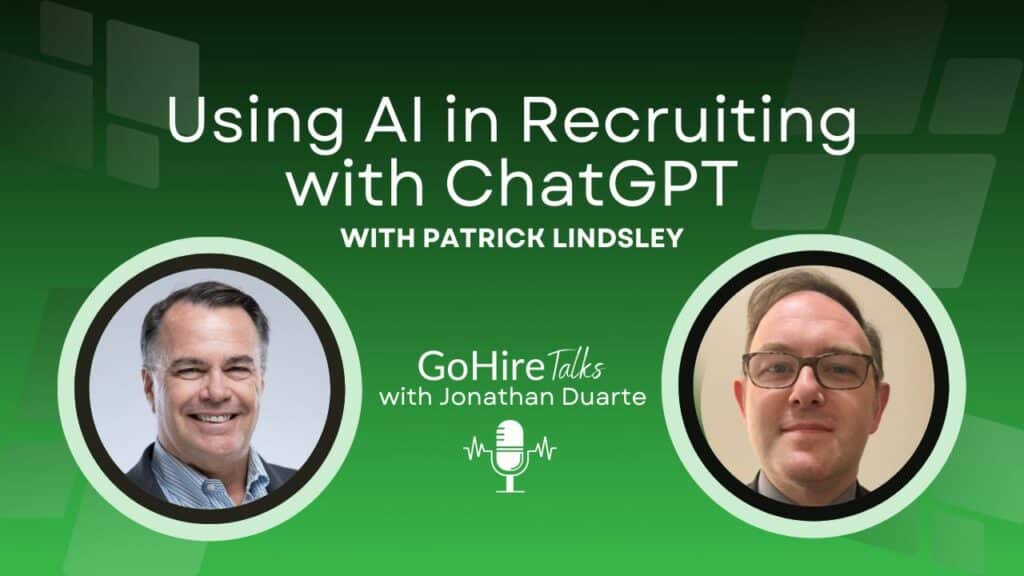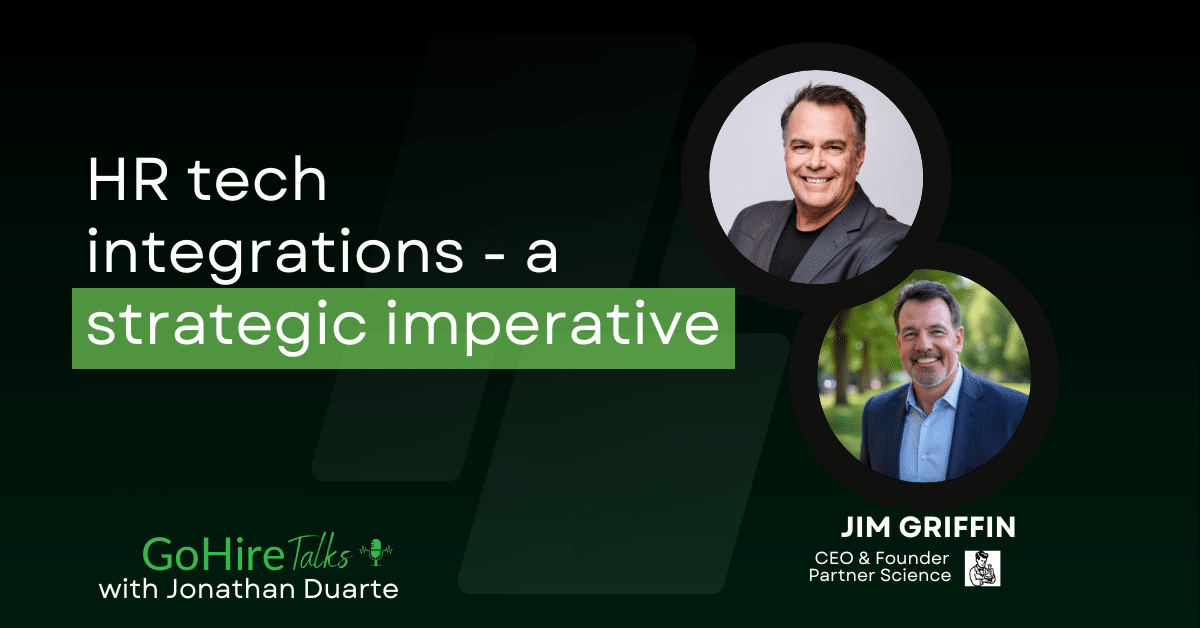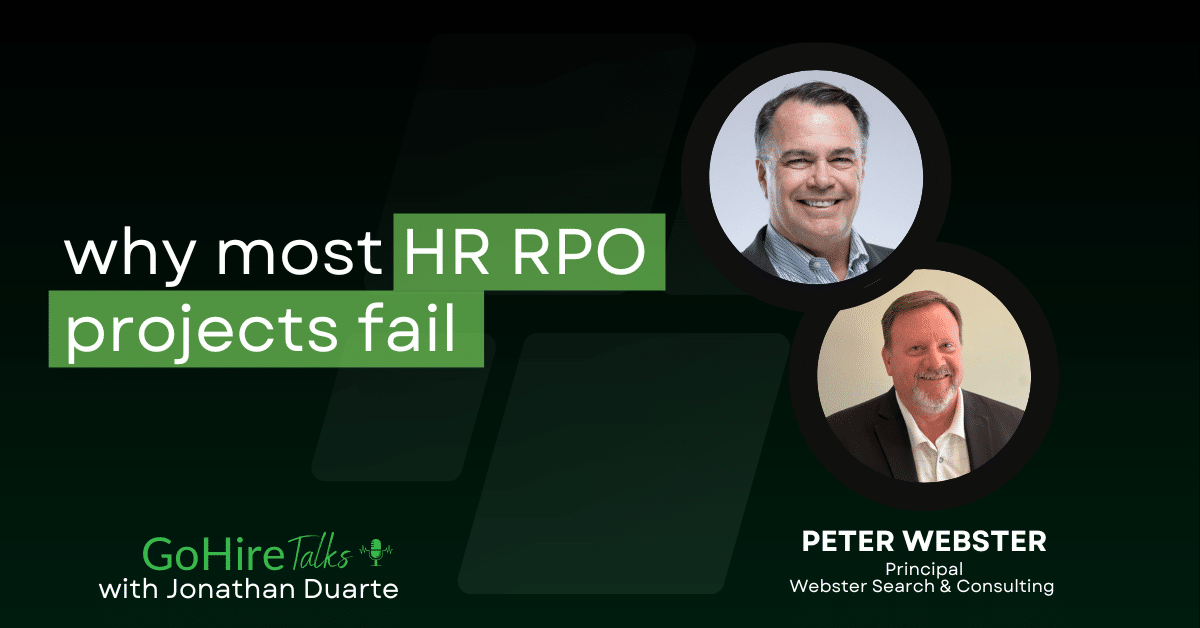
In this GoHire Talks episode, we dive into using AI in recruiting with Patrick Lindsley, a seasoned Recruiting Operations Director with two decades of experience, from building recruiting processes, ai recruitment tools, and tech stacks from the bottom up.
Patrick shares how his “AI aha moment” came when ChatGPT helped him analyze and improve his recruiting workflow – revealing massive gains in sourcing efficiency and candidate quality. AI technology is the driving force behind these changes, enabling organizations to transform their recruitment strategies and stay competitive.
From navigating 700 applicants for a single role to boosting candidate engagement with personalized AI-generated InMails, Patrick explains how AI in recruiting is no longer a futuristic idea—it’s a must-have advantage. AI is now used to enhance efficiency by automating repetitive tasks, optimizing workflows, and enabling faster, more effective hiring decisions.
He discusses how tools like ChatGPT, Claude, Perplexity, and sourcing platforms like SeekOut and HireEZ are transforming the recruiter’s daily workflow. AI technology is streamlining hiring processes by automating sourcing, screening, scheduling, and candidate evaluation, making recruitment more efficient and improving the overall candidate experience. The conversation is packed with practical advice for writing better AI recruiting prompts, building sourcing stacks, creating a better candidate experience, and navigating the emerging landscape of generative AI use cases in HR.
Whether you’re a recruiter, TA leader, or HR technologist, this episode highlights actionable strategies to stay ahead and avoid AI burnout.
Introduction to AI Recruitment
AI recruitment is revolutionizing the hiring process by leveraging artificial intelligence to streamline and enhance every stage of talent acquisition. With the rise of advanced ai recruiting tools, recruiters can now automate time-consuming tasks such as candidate sourcing, resume screening, and scheduling interviews. This shift allows human recruiters to focus on high-value interactions with top candidates, improving both efficiency and outcomes.
By integrating ai powered tools into their recruitment process, companies can make smarter, data-driven decisions that reduce hiring costs and accelerate time to hire. AI recruitment enables personalized job recommendations, helping candidates find roles that truly match their skills and aspirations, while also ensuring a smoother, more engaging candidate experience. As artificial intelligence continues to evolve, it’s clear that ai recruiting is not just a trend—it’s a fundamental shift in how organizations attract, assess, and hire the best talent.
Key Insights from Patrick’s Use of AI Recruiting Tools
ChatGPT helped improve sourcing efficiency by tripling quality sourcing hours per week.
Recruiters can use AI tools to analyze their own workflows and improve productivity.
AI tools like Perplexity and Claude are ideal for market research and messaging customization.
700 applicants, only 4 quality fits—AI helped sort the noise.
Prompt engineering is the new power skill for recruiters.
Recruiter burnout can be reduced with smart AI powered tools integration, which automates manual tasks and frees up time for more strategic work.
Sourcing tools like SeekOut and HireEZ offer edge cases LinkedIn alone misses.
Using AI in Recruiting: Patrick Lindsley’s Game-Changing Aha Moment
Patrick’s aha moment came when he used ChatGPT to analyze his recruiting process and realized his ratios of quality candidates were dropping. By leveraging AI to recognize patterns in recruiting data, he was able to identify areas for improvement. Despite a surge in well-crafted resumes, only 1 or 2 of every 10 interviews were quality leads. By feeding his process into ChatGPT, he discovered areas for optimization and the result was a major leap in productivity.
Using ChatGPT to Improve Sourcing Efficiency and Candidate Quality
Patrick used ChatGPT to analyze job fit and proactively identify potential candidates who best match the role, as well as to identify resume gaps and craft personalized messages. The tool allowed him to jump from 2-3 hours of quality sourcing per week to nearly 10. Customized InMails improved his response rates significantly—sometimes up to 50%. That’s the ROI $20 a month can deliver.
How Generative AI Use Cases in HR Are Redefining Recruiter Productivity
Generative AI isn’t just about automation—it’s about enhancement. By automating repetitive tasks such as resume screening, interview scheduling, and sourcing, generative AI streamlines recruiting workflows and frees up recruiters for more strategic work. Patrick explained how even basic prompt workflows can simulate having a second or third recruiter by your side. Recruiters can pre-train ChatGPT to audit workflows, write email sequences, and summarize resumes with surprising accuracy.
Building Smarter Recruiting Workflows with SeekOut, HireEZ, and Instantly
Patrick recommends combining platforms like SeekOut and HireEZ with ai recruiting tools like Instantly.ai. These platforms are examples of recruiting software that streamline the recruitment process by automating tasks such as resume screening, candidate matching, and workflow automation. These tools not only scrape data but allow multi-step email sequencing and integrations with CRMs. SeekOut’s GitHub search, for example, uncovers developers not even listed on LinkedIn.
From 700 Resumes to 4 Candidates: Why AI Powered Recruiting is Critical for Modern Recruiters
When one job post drew 700 applicants, Patrick relied on AI to help validate his shortlisting instincts. More than half of recruiters find shortlisting candidates from such large applicant pools to be the most challenging part of the process. Despite the volume, only 4 resumes were a true fit. ChatGPT helped him pinpoint patterns—like identifying candidates who worked at small startups with broader skill sets versus siloed big-tech specialists.
ChatGPT, Claude, and Perplexity: Choosing the Right AI Tool for Recruiting
Patrick uses ChatGPT for workflows and messaging, Claude for writing support, and Perplexity for deep research. He even has AI build cheat sheets on technical roles to prep for hiring manager meetings—bridging the knowledge gap in 15 minutes. These tools also help internal teams prepare for recruitment discussions, ensuring they are equipped with the necessary insights to support effective hiring.
Recruiting Prompts: The Hidden Skill That Changes Everything
Prompt engineering is no longer optional. Patrick emphasizes crafting personas, assigning identities to the AI, and continuously refining prompts. Even asking ChatGPT “How can I improve my workflow?” returned insights that made him better at his job.
By leveraging effective prompt engineering, recruiters can automate routine tasks and dedicate more time to strategic initiatives that drive better recruitment outcomes.
Reducing Recruiter Burnout with AI Agents and Automation
Burnout is real, especially when administrative tasks pile up. Patrick explains how AI tools free up time for conversations and relationship-building—the parts of recruiting that matter. Smart automation means less time chasing, more time connecting. By automating repetitive tasks and leveraging AI agents for resume screening and interview scheduling, recruiters benefit from reducing time to hire, making the entire process faster and more efficient for both candidates and hiring teams.
The Real Impact of Generative AI in Talent Acquisition Stacks
Generative AI isn’t just a plug-in; it’s a paradigm shift. TA leaders need to evaluate their tech stack and rethink recruiter roles. Tools that don’t integrate or scale with AI may already be outdated.
For organizations aiming to stay competitive in talent acquisition, successful AI implementation is essential to drive efficiency, enhance candidate experience, and enable data-driven decision-making.
Challenges and Limitations of AI Recruitment
While AI recruitment offers significant advantages, it also presents unique challenges and limitations that hiring teams must navigate. One major concern is the risk of unconscious bias embedded within ai systems. If the training data used to develop ai models reflects existing biases, these can be perpetuated throughout the recruitment process, potentially impacting fairness and diversity.
Another challenge is the lack of transparency in how some ai recruitment tools make decisions, making it difficult for HR professionals to fully understand or trust the outcomes. Over-reliance on ai tools can also lead to reduced human oversight, which is essential for ensuring that the recruitment process remains fair, inclusive, and aligned with organizational values. To address these issues, it’s crucial to combine the strengths of ai recruitment with human judgment, regularly review training data, and maintain clear decision-making processes that prioritize transparency and accountability.
Best Practices for AI Recruitment
To maximize the benefits of ai recruitment tools, HR professionals and hiring managers should follow a set of best practices that ensure effective and ethical integration into the hiring process. Start by selecting ai tools that are transparent, fair, and designed to minimize bias. Human oversight is essential—recruitment tools should support, not replace, the expertise and intuition of your team.
Training is key: ensure your HR team understands how to use ai recruitment tools and interpret their results. Regularly monitor and evaluate the performance of these tools to confirm they are meeting your recruitment strategies and delivering a positive hiring experience. By continuously refining your approach and staying informed about the latest advancements, you can use ai to enhance your recruitment process, attract top talent, and create a more efficient and equitable hiring journey.
The Impact of AI on Candidate Experience
AI is transforming the candidate experience by making the hiring process more personalized, efficient, and responsive. With ai powered tools, candidates receive tailored job recommendations that match their skills and interests, while automated systems streamline applications and speed up communication. AI chatbots can guide candidates through the process, answer questions, and provide timely feedback, reducing uncertainty and improving engagement.
However, it’s important to remember that technology should enhance—not replace—the human element of recruiting. High-value interactions and relationship building remain crucial for attracting and retaining top talent. By thoughtfully integrating ai tools into the hiring process, companies can deliver a standout candidate experience that combines the best of both technology and personal connection.
AI Recruitment and Diversity and Inclusion
AI recruitment tools have the potential to advance diversity and inclusion by helping companies reach a broader, more diverse pool of candidates and by reducing unconscious bias in the hiring process. When designed and implemented thoughtfully, ai tools can analyze job descriptions for biased language, ensure fair screening, and use diverse training data to make more objective decisions.
To truly promote equity, it’s essential that ai recruitment tools are transparent and explainable, allowing HR professionals to understand and trust the decision-making process. By using ai to identify and mitigate biases, companies can create a more level playing field for all prospective employees and improve the overall quality of their hires. Ultimately, using ai in recruitment is not just about efficiency—it’s about building a more inclusive and forward-thinking workforce.
Using AI in Recruiting with ChatGPT - Transcript and timelines
📢 Welcome & AI Aha Moments
[00:00:00 – 00:01:38]
Jonathan Duarte welcomes Patrick Lindsley and introduces the theme of “AI aha moments” in recruiting, setting the stage for a deep dive into how AI is transforming TA workflows.
🧠 From No Internet to AI Recruiting
[00:01:38 – 00:03:19]
Patrick reflects on the early days of recruiting—before internet and automation—highlighting how far tools like ChatGPT have come in redefining sourcing strategies.
🔍 The Resume Quality Paradox
[00:03:19 – 00:04:40]
Patrick shares how resume quality has improved, but actual candidate fit has declined. AI helped validate his process and uncover the root issue.
🛠️ ChatGPT as a Workflow Auditor
[00:04:40 – 00:05:46]
Patrick explains how using AI to audit his recruiting workflow led to optimized messaging, better outreach, and measurable gains in productivity.
✉️ Personalized Messaging at Scale
[00:05:46 – 00:07:16]
Using ChatGPT, Patrick moved from manual InMail crafting to scalable customization, increasing sourcing time and significantly boosting reply rates.
💸 ROI of AI Tools vs. LinkedIn Recruiter
[00:07:16 – 00:08:15]
The conversation compares the cost-effectiveness of ChatGPT ($20/month) to expensive recruiter licenses, reinforcing the value of AI recruiting tools.
💬 Claude, Custom Prompts & Candidate Fit
[00:08:15 – 00:09:57]
Patrick highlights how Claude and ChatGPT help identify not just job fit, but role depth, company size context, and hands-on experience.
🔎 700 Applicants, 4 Hires
[00:09:57 – 00:11:39]
Faced with 700 job applications, Patrick used AI to efficiently triage resumes and surface quality candidates, reducing resume fatigue.
🧱 Prompt Engineering for Recruiters
[00:11:39 – 00:13:00]
Jonathan and Patrick emphasize the rising importance of prompt engineering in HR tech and recruiting—where the right instructions make or break AI success.
💼 Estimating Salaries & Market Fit
[00:13:00 – 00:14:15]
Patrick used AI to estimate candidate salary expectations based on location, seniority, and role—often matching real-world expectations.
🧑🏫 Recruiter Prep & AI Cheat Sheets
[00:14:15 – 00:16:00]
AI became a pre-intake prep assistant for Patrick, offering domain-specific cheat sheets and helping bridge recruiter-hiring manager gaps.
🧩 Beyond ChatGPT: Perplexity & Claude
[00:16:00 – 00:17:20]
Different tools for different needs: Patrick breaks down why he uses Perplexity for research and Claude for better AI writing experiences.
🔄 Recruiter Burnout & AI Automation
[00:17:20 – 00:18:54]
The duo discusses how automation and workflow tools help reduce recruiter burnout by eliminating tedious, repetitive administrative work.
🧰 Building the Modern Recruiting Stack
[00:18:54 – 00:22:15]
Patrick walks through how he’s built recruiting tech stacks from scratch—integrating AI tools to increase throughput and reduce inefficiencies.
🧪 Tools: SeekOut, HireEZ & Instantly
[00:22:15 – 00:27:15]
An in-depth breakdown of sourcing tools including SeekOut, HireEZ, and Instantly for outreach sequences and GitHub scraping.
🚀 Final Thoughts & Leading AI Change
[00:27:15 – 00:34:15]
Patrick and Jonathan reflect on the need for every recruiter and HR leader to experience their own AI aha moment in order to lead workforce transformation.
About the Guest
Thanks to Patrick Lindsley for sharing his insights. Patrick is a seasoned Recruiting Operations leader with expertise in sourcing automation and HR tech. Connect with him on LinkedIn.


 06 October, 2025
06 October, 2025


